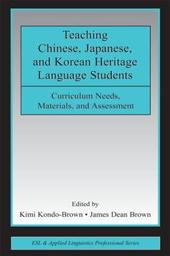
|
Teaching Chinese, Japanese, and Korean Heritage Language Students: Curriculum Needs, Materials, and Assessment
Paperback
Main Details
| Title |
Teaching Chinese, Japanese, and Korean Heritage Language Students: Curriculum Needs, Materials, and Assessment
|
| Authors and Contributors |
Edited by Kimi Kondo-Brown
|
|
Edited by James Dean Brown
|
| Series | ESL & Applied Linguistics Professional Series |
|---|
| Physical Properties |
| Format:Paperback | | Pages:368 | | Dimensions(mm): Height 229,Width 152 |
|
| ISBN/Barcode |
9780805858785
|
| Classifications | Dewey:370.1175 |
|---|
| Audience | | Postgraduate, Research & Scholarly | | Professional & Vocational | |
|---|
| Illustrations |
black & white illustrations
|
|
Publishing Details |
| Publisher |
Lawrence Erlbaum Associates Inc
|
| Imprint |
Lawrence Erlbaum Associates Inc
|
| Publication Date |
11 October 2007 |
| Publication Country |
United States
|
Description
This book contributes to building the research knowledge that language teaching professionals need in developing curriculum for the large population of East Asian heritage students (including Chinese, Japanese, and Korean) in countries like the United States, Canada, and Australia, where speakers of East Asian languages are among the fastest growing populations. Heritage learners are defined as those who initially acquired certain levels of linguistic and cultural competence in a non-dominant language mainly through interaction with foreign-born parents and other family members at home. Heritage language instruction is currently a "hot topic" and is becoming a sub-discipline within the fields of foreign language education and applied linguistics. Special instruction for heritage language learners is on the rise, particularly in the U.S. and Canada. Providing theoretical and practical information about heritage-language instruction in terms of curriculum design, learner needs, materials development, and assessment procedures, the goal of this book is not only to promote research about heritage students in East Asian languages but also to improve the teaching of these students in various educational settings and all over the world, especially in English speaking countries. The volume is organized in four sections: *Overview-addressing the timeliness, necessity, and applications of the work and issues and future agendas for teaching Chinese, Japanese, and Korean heritage students; *Language Needs Analysis; *Attitude, Motivation, Identity, and Instructional Preference; and *Curriculum Design, Materials Development, and Assessment Procedures Teaching Chinese, Japanese, and Korean Heritage Language Students is intended as a primary text or reference for researchers, educators, and students in the areas of curriculum, pedagogy, and assessment studies related to teaching bilingual and heritage students in general and East Asian heritage students in particular.
Reviews"...this book provides a much needed contribution to the understanding of East Asian HL learners. Indeed, much of this work is relevant to foreign language educators in general. Those interested in needs assessment and curriculum development will particularly enjoy this text." -- Tim Newfields, TESL-EJ, June 2008, Volume 12, Number 12
|